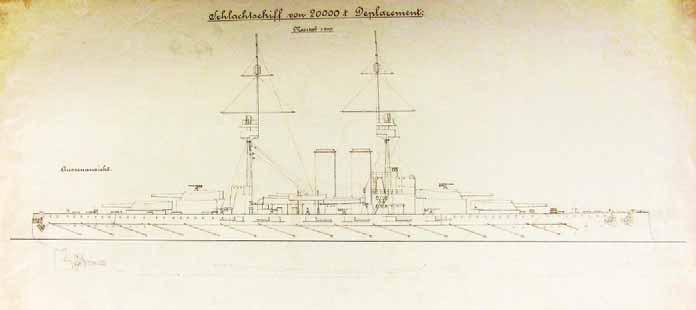34.5 cm turrets had a complicated design due to the any-angle loading requirement which was more complex than those on British battleships. Thanks to the any-angle loading system these turrets were overly large and heavy, while on the other hand poorly protected.592 In May 1912, the MTK advised not to use the any-angle loading system and instead use a fi xed-angle loading system. In June 1912, the Navy decided these ships would use a new, 35 cm caliber and that they would have a simpler, fi xed loading angle. This decision made it possible to reduce the barbette diameter of the 35 cm triple turret from 11.2 m to 10.3 m. The barbette diameter of the twin turret was 8.5 m. The new turret designs, thanks to the fi xed loading angle, were lighter than the 34.5 cm ones, despite having heavier, larger caliber guns and their thicker turret armor. The few plans available show that the elevation range of these guns was -4/+16 degrees. Probably the Navy intended to build these turrets with the same sort of couplings as used on the 30.5 cm triples. On the evidence of the 24,500 ton battleship plans these turrets would have had interrupted ammunition hoists and a true handling room two levels below the gunhouse. The turrets would have 5 m rangefinders but not in cupolas. Instead, they would be under the roof armor looking out through periscopes under small armored hoods. The Austro-Hungarian Navy identified the gun turrets by Roman numerals instead of letters, which ran from fore to aft. On the Radetzky class the six turrets were numbered clockwise, starting from the fore 30.5 cm turret as on the German Nassau class. Casemates were also identified by Roman numerals. Fire Control A post-war American report describes the fire control system of the Austro-Hungarian battleships as: “This system was patterned after the German system but did not, as a result of the war, keep pace with the improvements made in Germany nor did it represent the latest developments of fire control as used in the German Navy. All of the apparatus described in the above report represented very obsolete apparatus as far as Germany was concerned and can therefore be only of interest from an historical point of view. […] In all other respects the
Austrian fire control does not deserve serious consideration by the Department as the German fire control has already been submitted fully and in detail, and as the latter only, offers points for study by the Bureau for Ordnance.”593 These lines were written by the US Naval Attaché in Berlin, W. P. Beehler in October 1922. He sent a report on Austro-Hungarian fire control to the Director of Naval Intelligence which was compiled from narrations of former Austro-Hungarian officers. The file contains also a report from February 1914, written by an US naval officer, who was allowed to see the fire control system of the Tegetthoff. These two American reports are among the most important sources of the fire control system of the Austro-Hungarian battleships. Friedrich Prasky in his book on the Tegetthoff class also deals with the fire control system in details.594 Beside these there are several documents which contain more or less information about this fire control system. The original, pre-war fire control system of the most modern Austro-Hungarian battleships (Radetzky and Tegetthoff classes) was quite simple. On these battleships there were no plotters, plotting rooms, complex systems or sophisticated mechanical calculators. The most sophisticated elements of the Austro-Hungarian fire control system were the Barr & Stroud rangefinders and the Siemens & Halske DC communicating apparatuses (transmitters and receivers).595 The Navy made a report for internal use on the fire control, which found it very obsolete. This report suggests that the Navy may have used some simple Dumaresq-like device,596 but other sources do not confirm this.597 Each of the Radetzky class and the Tegetthoff class battleships had two main fire control stations, one in the fore and one in the aft conning tower. The ships had two “wing” control stations for the secondary battery, on the Radetzkys integrated into the superstructure, while the Tegetthoff s had free standing control towers. On each ship all four control stations had their own rangefinders. The battleships of the Radetzky class had four 9-foot (2,743 mm), while the units of the Tegetthoff -class had two 12-foot (3,658 mm) and six 9-foot Barr & Stroud rangefinders.598 On the latter class every gun turret was fitted with a rangefinder. All of the battleships of both classes had two fully equipped fire control positions which were located fore and aft under the armored deck. These were intended
— 167 —






























